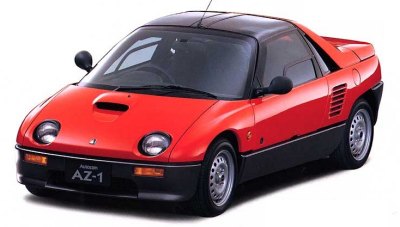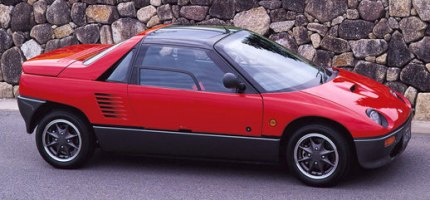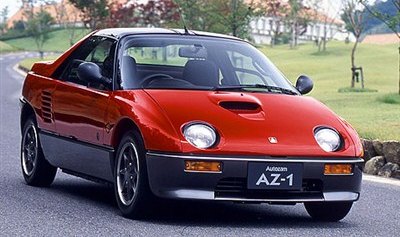 In the early 1990s, a trio
of mini sports cars built to Kei-car specifications was born. Japanese
motoring enthusiasts called them "ABC", which denotes Mazda AZ-1, Honda Beat and Suzuki Cappucino. The Suzuki was the most
conventional of them, being front-engined and convertible. Both the
Mazda and Honda were mid-engined mini-exotic, but I suppose the Mazda
was the more spectacular of the two, no matter judging from its
mini-Ferrari looks or gullwing doors. Unfortunately, a combination of
high-price and recession led to its short life. Just over 4,000 units
were sold from 1992-94. Today, AZ-1 becomes a collector's favour.
 I have been admiring AZ-1 for long, as shown by the
inclusion of it in the previous Strange Car Archive. Last year, I
finally had a close encounter with an AZ-1, one of the 4392 cars ever
built. The red machine was in perfect condition - clean, fresh and
flawless. It looked just as spectacular as 2 decades ago. The first
thing to catch your attention is its smallness - this car measures no
more than 3.4 meters long and 1.4 meters wide. At 1150 mm tall, it is
actually lower than a Lamborghini Gallardo, but you won't know that
until you squeeze into the cabin, which is tight for anyone taller than
5 ft 9. However, it is a place everyone wants to be in, because it
gives you the sensation only the most exotic supercars can deliver. You
sit on the high door sill, swing your legs into the footwell like a
gymnastic player, move your bottom into the small bucket seat, raise
you arm to close the gullwing door, then the glasshouse is right above
your head. The glasshouse gives you excellent all round visibility and
an air of freedom. Due to its narrowness, the seats are put very close
together, and shoulder room is so tight that you have to operate the
manual winding window with youir opposite arm. Nevertheless, behind the
seats there is some space for the spare tire or luggage.
 The AZ-1 program was a joint-venture with Suzuki. Mazda was
responsible for its design, overall engineering and assembly, while
Suzuki supplied its 660cc engine, 5-speed gearbox and many other
components from its K-car parts pool. This is not much of a surprise as
Mazda has always been outsourcing its K-cars from Suzuki. The
joint-venture also produced a sister car, Suzuki Cara. As shown in the
blue car pictured above, Cara was identical to AZ-1 except the
additional fog lights.
The car had a steel chassis clothed in body panels made of glass-fiber reinforced plastic to save weight. Suspensions were MacPherson struts all round. Like FIAT X1/9, Toyota MR2 or just any mid-engined small cars, the powertrain of AZ-1 was mounted transversely between the rear wheels, so strictly speaking it was not exactly mid-engined. However, thanks to the small powertrain, front to rear weight distribution was good at 44:56. The 657 c.c. turbocharged and intercoolered 3-cylinder 12-valve engine was identical to that of the Suzuki Cappucino. It made 64 horsepower, the maximum allowed by the K-car regulations, but produced significantly more mid-range and peak torque than the naturally aspirated engine of Honda Beat. Coupling to a 720 kg kerb weight, the little car was pretty quick.  The driving experience was highlighted by the whoosh of the
wastegate and the very quick steering. With just 2.2 turns from lock to
lock, and little weight at the nose to deal with, the steering was
sensitive to the point of nervous. Although the heavier tail offered
good grip and traction, once its limit is exceeded, you have to catch
the tail immediately with opposite lock. The AZ-1 was not a car
designed for power slide. Like its mini-supercar looks suggested, it
had to be respected.
|